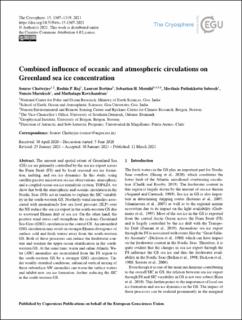| dc.contributor.author | Chatterjee, Sourav | |
| dc.contributor.author | Raj, Roshin Pappukutty | |
| dc.contributor.author | Bertino, Laurent | |
| dc.contributor.author | Mernild, Jacob Sebastian Haugaard | |
| dc.contributor.author | Subeesh, Meethale P. | |
| dc.contributor.author | Murukesh, Nuncio | |
| dc.contributor.author | Ravichandran, Muthalagu | |
| dc.date.accessioned | 2021-08-06T09:50:54Z | |
| dc.date.available | 2021-08-06T09:50:54Z | |
| dc.date.created | 2021-03-16T10:41:28Z | |
| dc.date.issued | 2021 | |
| dc.identifier.issn | 1994-0416 | |
| dc.identifier.uri | https://hdl.handle.net/11250/2766769 | |
| dc.description.abstract | The amount and spatial extent of Greenland Sea (GS) ice are primarily controlled by the sea ice export across the Fram Strait (FS) and by local seasonal sea ice formation, melting, and sea ice dynamics. In this study, using satellite passive microwave sea ice observations, atmospheric and a coupled ocean-sea ice reanalysis system, TOPAZ4, we show that both the atmospheric and oceanic circulation in the Nordic Seas (NS) act in tandem to explain the SIC variability in the south-western GS. Northerly wind anomalies associated with anomalously low sea level pressure (SLP) over the NS reduce the sea ice export in the south-western GS due to westward Ekman drift of sea ice. On the other hand, the positive wind stress curl strengthens the cyclonic Greenland Sea Gyre (GSG) circulation in the central GS. An intensified GSG circulation may result in stronger Ekman divergence of surface cold and fresh waters away from the south-western GS. Both of these processes can reduce the freshwater content and weaken the upper-ocean stratification in the south-western GS. At the same time, warm and saline Atlantic Water (AW) anomalies are recirculated from the FS region to the south-western GS by a stronger GSG circulation. Under weakly stratified conditions, enhanced vertical mixing of these subsurface AW anomalies can warm the surface waters and inhibit new sea ice formation, further reducing the SIC in the south-western GS. | en_US |
| dc.language.iso | eng | en_US |
| dc.rights | Navngivelse 4.0 Internasjonal | * |
| dc.rights.uri | http://creativecommons.org/licenses/by/4.0/deed.no | * |
| dc.title | Combined influence of oceanic and atmospheric circulations on Greenland sea ice concentration | en_US |
| dc.type | Journal article | en_US |
| dc.type | Peer reviewed | en_US |
| dc.description.version | publishedVersion | en_US |
| dc.rights.holder | Copyright 2021 The Authors | en_US |
| cristin.ispublished | true | |
| cristin.fulltext | original | |
| cristin.qualitycode | 2 | |
| dc.identifier.doi | 10.5194/tc-15-1307-2021 | |
| dc.identifier.cristin | 1898285 | |
| dc.source.journal | The Cryosphere | en_US |
| dc.source.pagenumber | 1307-1319 | en_US |
| dc.identifier.citation | The Cryosphere. 2021, 15 (3), 1307-1319. | en_US |
| dc.source.volume | 15 | en_US |
| dc.source.issue | 3 | en_US |

